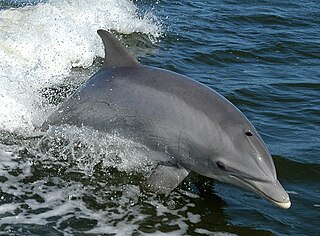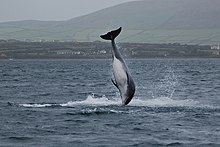
Cetacea is an infraorder of aquatic mammals belonging to the order Artiodactyla that includes whales, dolphins and porpoises. Key characteristics are their fully aquatic lifestyle, streamlined body shape, often large size and exclusively carnivorous diet. They propel themselves through the water with powerful up-and-down movement of their tail which ends in a paddle-like fluke, using their flipper-shaped forelimbs to maneuver.

Whales are a widely distributed and diverse group of fully aquatic placental marine mammals. As an informal and colloquial grouping, they correspond to large members of the infraorder Cetacea, i.e. all cetaceans apart from dolphins and porpoises. Dolphins and porpoises may be considered whales from a formal, cladistic perspective. Whales, dolphins and porpoises belong to the order Cetartiodactyla, which consists of even-toed ungulates. Their closest non-cetacean living relatives are the hippopotamuses, from which they and other cetaceans diverged about 54 million years ago. The two parvorders of whales, baleen whales (Mysticeti) and toothed whales (Odontoceti), are thought to have had their last common ancestor around 34 million years ago. Mysticetes include four extant (living) families: Balaenopteridae, Balaenidae, Cetotheriidae, and Eschrichtiidae. Odontocetes include the Monodontidae, Physeteridae, Kogiidae, and Ziphiidae, as well as the six families of dolphins and porpoises which are not considered whales in the informal sense.

Whale watching is the practice of observing whales and dolphins (cetaceans) in their natural habitat. Whale watching is mostly a recreational activity, but it can also serve scientific and/or educational purposes. A study prepared for International Fund for Animal Welfare in 2009 estimated that 13 million people went whale watching globally in 2008. Whale watching generates $2.1 billion per annum in tourism revenue worldwide, employing around 13,000 workers. The size and rapid growth of the industry has led to complex and continuing debates with the whaling industry about the best use of whales as a natural resource.

The southern right whale is a baleen whale, one of three species classified as right whales belonging to the genus Eubalaena. Southern right whales inhabit oceans south of the Equator, between the latitudes of 20° and 60° south. In 2009 the global population was estimated to be approximately 13,600.

The toothed whales are a clade of cetaceans that includes dolphins, porpoises, and all other whales with teeth, such as beaked whales and the sperm whales. 73 species of toothed whales are described. They are one of two living groups of cetaceans, the other being the baleen whales (Mysticeti), which have baleen instead of teeth. The two groups are thought to have diverged around 34 million years ago (mya).

The tropical bottlenose whale, also known as the Indo-Pacific beaked whale or Longman's beaked whale, was considered to be the world's rarest cetacean until recently, but the spade-toothed whale now holds that position. As of 2010, the species is now known from nearly a dozen strandings and over 65 sightings. This is the only species in the genus Indopacetus.

The pygmy killer whale is a poorly known and rarely seen oceanic dolphin. It is the only species in the genus Feresa. It derives its common name from sharing some physical characteristics with the orca, also known as the killer whale. It is the smallest cetacean species that has the word "whale" in its common name. Although the species has been known to be extremely aggressive in captivity, this aggressive behavior has not been observed in the wild.

The Indo-Pacific bottlenose dolphin is a species of bottlenose dolphin. This dolphin grows to 2.6 m (8.5 ft) long, and weighs up to 230 kg (510 lb). It lives in the waters around India, northern Australia, South China, the Red Sea, and the eastern coast of Africa. Its back is dark grey and its belly is lighter grey or nearly white with grey spots.

The melon-headed whale, also known less commonly as the electra dolphin, little killer whale, or many-toothed blackfish, is a toothed whale of the oceanic dolphin family (Delphinidae). The common name is derived from the head shape. Melon-headed whales are widely distributed throughout deep tropical and subtropical waters worldwide, but they are rarely encountered at sea. They are found near shore mostly around oceanic islands, such as Hawaii, French Polynesia, and the Philippines.

The common bottlenose dolphin or Atlantic bottlenose dolphin is one of three species of bottlenose dolphin in the genus Tursiops. The common bottlenose dolphin is a very familiar dolphin due to the wide exposure it receives in human care in marine parks and dolphinariums, and in movies and television programs. Common bottlenose dolphins inhabit temperate and tropical oceans throughout the world, absent only from polar waters. While formerly known simply as the bottlenose dolphin, this term is now applied to the genus Tursiops as a whole. As considerable genetic variation has been described within this species, even between neighboring populations, many experts think additional species may be recognized.

The Atlantic white-sided dolphin is a distinctively coloured dolphin found in the cool to temperate waters of the North Atlantic Ocean.

A dolphinarium is an aquarium for dolphins. The dolphins are usually kept in a pool, though occasionally they may be kept in pens in the open sea, either for research or public performances. Some dolphinariums consist of one pool where dolphins perform for the public, others are part of larger parks, such as marine mammal parks, zoos or theme parks, with other animals and attractions as well.

Cetacean bycatch is the accidental capture of non-target cetaceans such as dolphins, porpoises, and whales by commercial fisheries. Bycatch can be caused by entanglement in fishing nets and lines, or direct capture by hooks or in trawl nets.
The Bottlenose Dolphin Research Institute (BDRI) is a research and educational centre dedicated to the understanding and conservation of cetaceans and the marine environment in which they live. The Institute's BDRI center was founded by the biologist Bruno Díaz López in Sardinia, Italy in 2005. In 2014, the BDRI opened a new facility in Galicia, Spain.

Whale conservation refers to the conservation of whales.

The southern bottlenose whale is a species of whale, in the ziphiid family, one of two members of the genus Hyperoodon. Seldom observed, the southern bottlenose whale is resident in Antarctic waters. The species was first described by English zoologist William Henry Flower in 1882, based on a water-worn skull from Lewis Island, in the Dampier Archipelago, Western Australia. They live in deep ocean waters over 1000 meters.

Whale watching in New Zealand is predominantly centred around the areas of Kaikōura and the Hauraki Gulf. Known as the 'whale capital', Kaikōura is a world-famous whale watching site, in particular for sperm whales which is currently the most abundant of large whales in New Zealand waters. The Hauraki Gulf Marine Park is also a significant whale watching area with a resident population of Bryde's Whales commonly viewed alongside other cetaceans Common Dolphins, Bottlenose Dolphins and Orca. Whale watching is also offered in other locations, often as eco-tours and in conjunction with dolphin watching. Land-based whale watching from New Zealand's last whaling station, which closed in 1964, is undertaken for scientific purposes, mostly by ex-whalers.

Fungie, also known as the Dingle Dolphin, was a male common bottlenose dolphin. He became separated from other wild dolphins and lived in very close contact with the people of Dingle on the southwest coast of Ireland.

The Irish Whale and Dolphin Group (IWDG) is a cetacean conservation and outreach organisation based in Ireland.
Cetaceans form an infra-order of marine mammals. In 2020, approximately 86 species of cetaceans had been identified worldwide. Among these species, at least 35 have been sighted in the wider Caribbean region with very widespread distribution and density variations between areas. Caribbean waters are a preferred breeding site for several species of mysticeti, who live further north the rest of the year. The tucuxi and the boto live at the southern periphery of the Caribbean region in the freshwaters of the Amazon River and surrounding drainage basins.




















